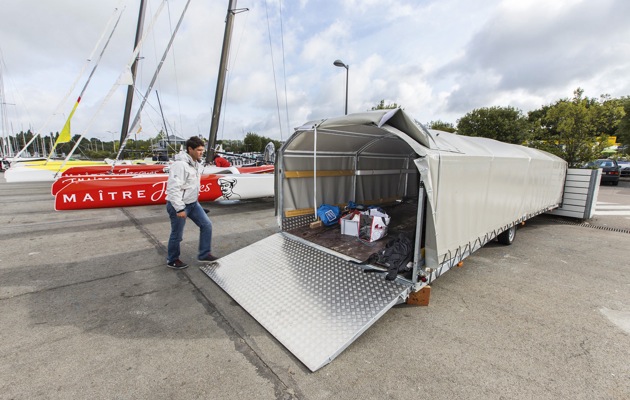Organisers of the Tour de France à la Voile hope to revitalise the team event by revamping the format and choosing a 24ft trimaran. James Boyd takes a close look at the boat
Boat is trailable
The boat is trailable and at the inaugural Marseille One Design event the two Diam 24s competing turned up neatly stowed on one trailer – something that will no doubt please the Tour Voile’s organisers.
While the three hulls are built using resin infusion in glass with a foam core, the rest of the boat is glassfibre, but with uni-directional carbon fibre reinforcement. This includes the two crossbeams, which should improve the trimaran’s longitudinal and diagonal rigidity. The foils have been upgraded over the Multi 23 and gone is the kick-up centreboard, to be replaced by a longer daggerboard and the single rudder in the main hull has been replaced by twin rudders – one in each float.
Lauriot Prévost explains: “Having two rudders, you can fly a hull [the main hull] and maintain good balance on the helm. The swinging daggerboard made sense in terms of grounding, but having one big daggerboard allows a more efficient blade.”
The boat certainly looks the part. With its heavily raked rig, low freeboard and its reverse dreadnought bows, it resembles a mini Banque Populaire or MOD70.
A significant element to trimaran design is to prevent pitchpoling and before foils were introduced to the floats to alleviate this, trimaran bows typically had maximum volume to keep them buoyant. However, according to Lauriot Prévost, the philosophy has now changed and the wave-piercing ability of the Diam 24’s sharp bows, combined with a V-section deck, means the boat doesn’t decelerate as much when encountering waves.
Low profile
To reduce weight, the main hull is low-profile, providing just enough freeboard for adequate clearance between the crossbeams and the sea. Its underwater shape is flat, terminating in a transom wide enough to mount an electric engine.
The floats have reasonably high volume, making them quite powerful, but Laurent Prévost explains this is necessary because, unlike most of the larger racing trimarans his company has designed over the past 20 years or so, there are no foils in the floats to provide vertical lift (these were deemed too expensive).
In addition, to give the boat a ‘racy look’, the severe 7-8° of mast rake has significant seakeeping functions, helping to lift the bows out of the water and improving the balance of the boat and its longitudinal stability when sailing, says Lauriot Prévost. As with most racing multihulls, the sail plan is simple, comprising just three sails: a square-topped main, small blade jib and a furling gennaker.
Exhilarating ride
The Diam 24 is not a state-of-the-art foiling multihull like the GC32, but, like the J/80, can provide an exhilarating ride for a crew of just three for a reasonable budget. The boat is capable of speeds into the mid-20s and, at around 500kg, is light enough to fly the main hull in just over ten knots of wind (with the crew on the centre hull rather than up to windward).
Apart from the Tour Voile, the Diam 24 already has a six-event circuit and its own class at events such as the Grand Prix Guyader. Diam 24-only events were held last year in La Trinité- sur-Mer, Lorient and, of course, Port la Fôret.
Clearly the boat has struck a chord. Since the first Diam 24 was launched in the spring of 2013 examples have been acquired by leading sailors, including Vendée Globe skippers Bernard Stamm, François Gabart and Vincent Riou, as well as Loic Féquet, skipper of the Multi 50 trimaran Maitre Jacques, and Commodores’ Cup winner Géry Trentesaux.
At the time of writing 31 teams had signed up for the 2015 Tour, which takes place on 3-26 July and starts in Dunkirk.
Dimensions
LOA 7.25m/23ft 9in
Beam 5.62m/18ft 4in
Mast height 12.20m/40ft 0in
Draught 1.50m/4ft 11in
Displacement 450kg/992lb
Sail areas:
Mainsail 22m2/237ft2
Solent 10m2/108ft2
Gennaker 32m2/344ft2
Designed by VPLP
This is an extract from a feature in the February 2015 issue of Yachting World






